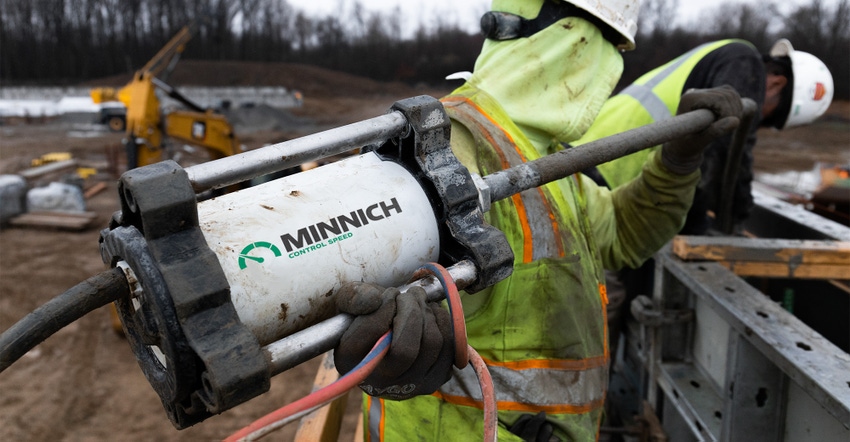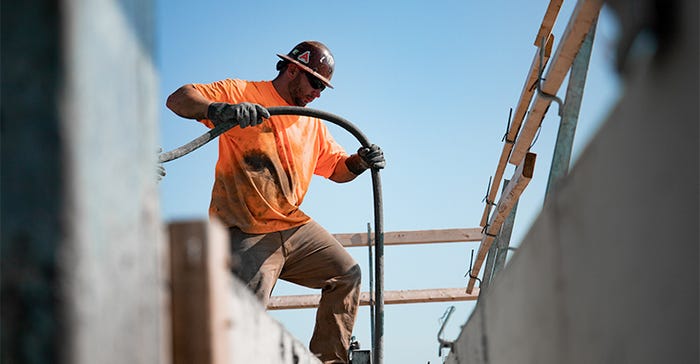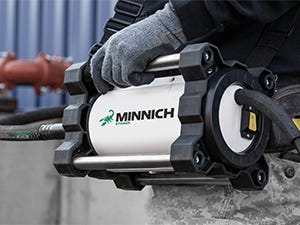The science behind Controlled Frequency Vibration standards
April 19, 2023

Concrete vibration is a vital part of any concrete pour. Due to the wide variability of concrete materials, moisture levels, batching uniformity, chemical incompatibilities and slump loss rates, vibrator speeds need to be controlled and predictable.
Vibration specifications were developed in the late 1960s after numerous vibration frequency testings, which concluded that the concrete vibration frequency should never exceed 10,000 vibrations per minute (vpm) due to the observation of concrete material separation. While this was a start to solving concrete blemishes and allowing for more workable concrete mixes, there was more to be tested.
In the later 1970s, mix designs were being transformed by a chemical additive called a water-reducing agent (WRA). While this development allowed concrete mixtures to be easily pumped into place, it also moved the product in the opposite direction of the design process it needed to go, causing a vibrator design disconnect. As a result, surface blemishes began appearing on the form face of freshly poured concrete surfaces. These blemishes were mistaken by contractors for entrapped air, and even more vibration was added to try and alleviate the problem.
It wasn’t until the mid-1990s that the concrete industry realized the previous issues were caused by frequency over vibration and concrete material separation.
Introducing controlled frequency vibration
Between the introduction of concrete mix designs, an evaluation of long-life road design was done in the late 1980s and found that there would be many advantages to changing pavement mix designs to match a successful and durable road model from Europe.

As the new pavement mix hit the paving scene, vibration problems began to multiply, which led to them being more thoroughly evaluated in the 1990s. Using a simple vibrator monitoring device, the machine operator could read the vibrator frequency. The Iowa Department of Transportation (DOT), along with the Federal Highway Administration, began using this device to research vibrator frequency compatibility. From this research, the organizations adopted several standards to address the damage to concrete by vibration frequency. This included the use of vibration monitoring systems and the eventual adoption of vibrator standards across individual state DOT levels.
The off-centered weights of paving vibrators became larger, vibrator frequencies were reduced, and the concrete testing agreed with the new direction of controlling vibration energy shown in Controlled Frequency Vibration (CFV)-type systems.
Today’s accepted standards recommend vibrator spacing at a 16-inch space maximum, the off-center weights at a set amplitude, the machine travel speeds in a range for the vibrator range and vibrator frequency ranges between 5,000 to 8,000 vpm.
Changes in Concrete Mixes Leaves Vibrator Designs Behind
The old method of loading and dumping concrete into the forms was laborious, leading to the development of a new pumping method. To allow for the ease of concrete passing through the pipes of the pump, the mix viscosity had to be reduced. The solution was a WRA mixed into the concrete to help make it easier to pump. It also reduced the amount of vibration energy needed, something vibrator operators were not aware of.
The lack of vibration industry controls, field research and standards to deal with the rising level of over-vibration were showing in the form of face defects. In hindsight, we understand concrete has been over-vibrated since the mid-1980s — although, at the time, vibrator operators believed the concrete suffered from honeycombs of under-vibration. The surface defects were instead caused by the available water movement due to high vibrator frequency.
In the mid-1990s, the industry vibrators used to vibrate concrete in the U.S. were brought in for an evaluation as part of a study. An identical vibrator in horsepower, shaft size and head diameter was obtained from five leading manufacturers and evaluated. The study found that all the vibrators ran higher frequencies than the ACI specification, and all ran differently from each other. This put a critical industry problem on display.
The chosen method of solving this unpredictability was to control the energy that came out of a vibrator, predict the effects of that energy and evaluate the energy against a changing concrete variability in batching, transport and placement.
What Happens When Predictive Vibration Is Not Enough
The vibration energy knowledge that was developed from road construction studies was then used to examine the issues with concrete structural surfaces in vertical and commercial concrete pours.
From pre-construction trials, vibrator frequency was lowered from between 13,000 and 17,000 vpm to a more compatible range for today’s concrete mixes — 6,000 to 8,000 vpm. This change reduced the phenomenon of driving available mix water of pumpable and near flowable mixes to the surface of the concrete forms. These unwanted blemishes make their way to the form surface and are often misidentified by vibrator operators as air voids from under vibration.
The wave concept of a vibrator is a helpful tool for understanding how to change vibrator settings for a more desirable outcome. Two waves transmit from the same vibrating head source — elevated pulsating pressure waves (p-waves) that help consolidate the concrete, and elevated shear waves (s-waves), which contribute to material separation. In understanding vibration wave energy behaviors, higher p-wave values can be applied while limiting s-wave values to consolidate while limiting the material separation.
This is where Controlled Frequency Vibration (CFV) comes in. A concrete vibrator with CFV can help researchers study forces at wave values and report performance back to the user. A CFV can sense a concrete load and report the data in the form of a curve via Bluetooth to an iOS or Android device. The load curve shows the resistance against the workability of the concrete being vibrated. Then, a workability log can be studied to bridge the gap between predictive vibration energy and changes that stem from inconsistent quality in batching, transporting and pumping.
Research into proper CFV is not enough, though. The other side of the equation is the variability in processes that affect concrete workability. With vibrator controls, predictability and vibrator workability curve reporting, researchers now have a measuring stick to evaluate the differences in load against the vibrating head that represent the level of concrete workability variances.
Using science-backed research, the concrete vibrator’s behavior and the changes in the concrete workability curve can be understood and better managed. A curve is logged upon the chosen mix design properties in the lab, then used to compare that load curve to curves from each ready-mix truck or pump operation for standard variances. With this information, the vibration frequency or wave manipulation can be adjusted for a more consistent result.
The current vibration research is no longer about the tool’s variability, but about the vibrator’s role as a measuring stick in understanding and adjusting to the variability in the concrete’s workability.
Research into Real-Time On-Site Quality Control Tools
Vibration studies have increased over the last two years and a few realizations have been made. The first is that over-vibration causes surface blemishes. The second is the more workable the concrete, the more control of vibrator frequency is needed, especially in pumpable and near flowable concrete mixtures. Even with this knowledge, vibration/mix compatibility should be part of any contractor’s quality control regimen before construction begins.

There are field trials that study the amount of vibration energy in pre-construction trials to make the construction outcome more predictive. In each, participating contractors prepare several wooden boxes to test the concrete by pouring mock-up forms. This pre-construction testing method is simple and more cost-effective than patching the structure’s surface later.
Researchers are working on quality control tests around a mixture’s bleed tendency or the change from slump variance. This work will help develop an easy, accurate and repeatable workability meter for concrete variances and how they will affect concrete construction.
If you are using a CFV and evaluating vibration curves as a source of controlling batching or transporting variances, the CFV reports a curve that can be compared to the curve reported at pre-construction trials. The contractor can take a log for each truck that is delivered to the jobsite by dipping a vibrator into the concrete for three seconds before vibration.
This research will be ongoing to link an accurate digital slump reading to the curve generated by a CFV that can be linked to other concrete placement loggings.
Vibrator knowledge has grown tremendously in recent years, leading the industry to better understand how to achieve a blemish-free pour. CFV research will continue to move forward as there’s still room to improve. Those findings and the science behind vibration will be at the forefront of how crews work, now and into the future, as contractors strive to produce the best possible outcome.
Interested in learning more? Contact Minnich Manufacturing today.
You May Also Like



